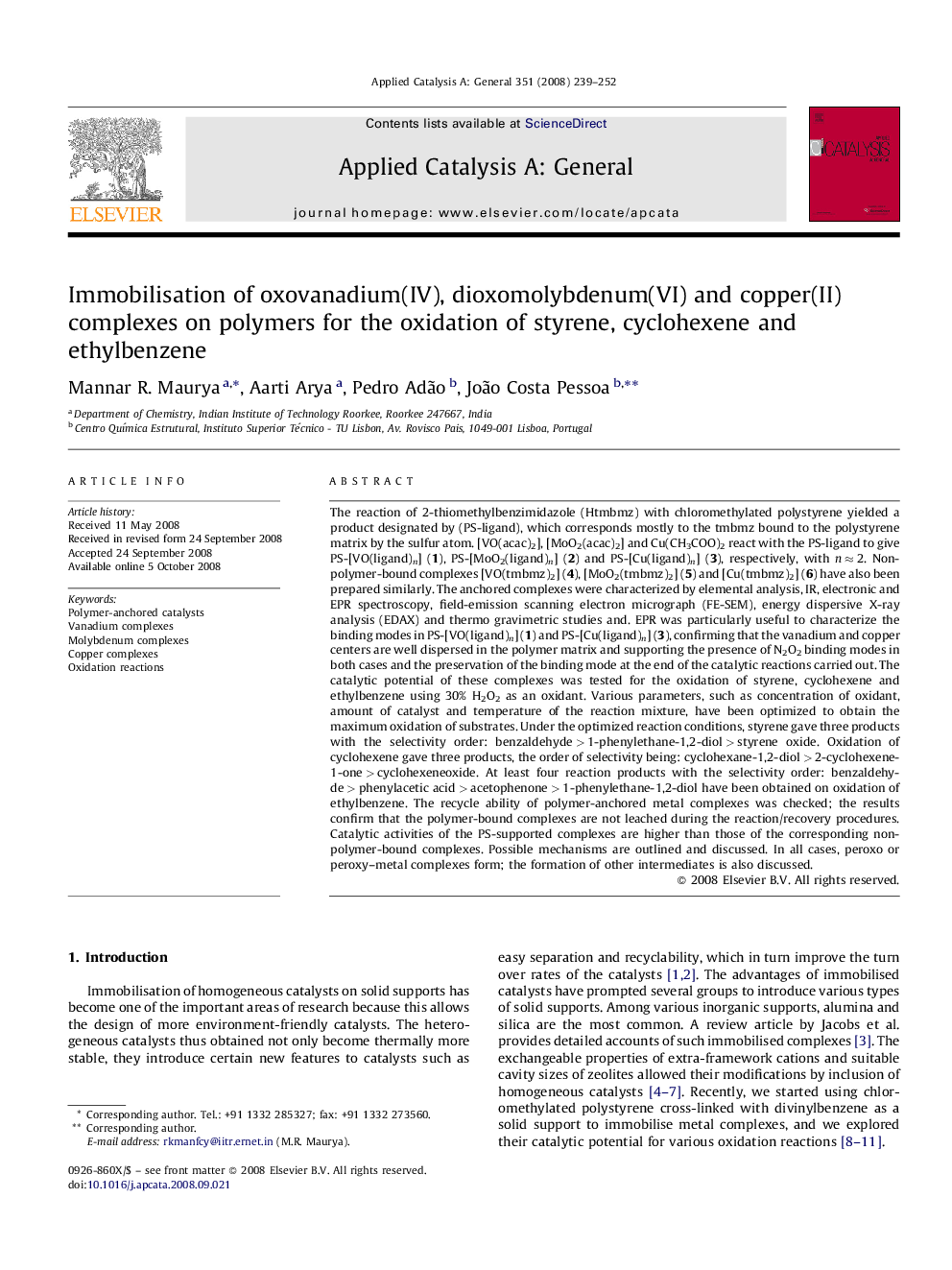| کد مقاله | کد نشریه | سال انتشار | مقاله انگلیسی | نسخه تمام متن |
|---|---|---|---|---|
| 43246 | 45959 | 2008 | 14 صفحه PDF | دانلود رایگان |

The reaction of 2-thiomethylbenzimidazole (Htmbmz) with chloromethylated polystyrene yielded a product designated by (PS-ligand), which corresponds mostly to the tmbmz bound to the polystyrene matrix by the sulfur atom. [VO(acac)2], [MoO2(acac)2] and Cu(CH3COO)2 react with the PS-ligand to give PS-[VO(ligand)n] (1), PS-[MoO2(ligand)n] (2) and PS-[Cu(ligand)n] (3), respectively, with n ≈ 2. Non-polymer-bound complexes [VO(tmbmz)2] (4), [MoO2(tmbmz)2] (5) and [Cu(tmbmz)2] (6) have also been prepared similarly. The anchored complexes were characterized by elemental analysis, IR, electronic and EPR spectroscopy, field-emission scanning electron micrograph (FE-SEM), energy dispersive X-ray analysis (EDAX) and thermo gravimetric studies and. EPR was particularly useful to characterize the binding modes in PS-[VO(ligand)n] (1) and PS-[Cu(ligand)n] (3), confirming that the vanadium and copper centers are well dispersed in the polymer matrix and supporting the presence of N2O2 binding modes in both cases and the preservation of the binding mode at the end of the catalytic reactions carried out. The catalytic potential of these complexes was tested for the oxidation of styrene, cyclohexene and ethylbenzene using 30% H2O2 as an oxidant. Various parameters, such as concentration of oxidant, amount of catalyst and temperature of the reaction mixture, have been optimized to obtain the maximum oxidation of substrates. Under the optimized reaction conditions, styrene gave three products with the selectivity order: benzaldehyde > 1-phenylethane-1,2-diol > styrene oxide. Oxidation of cyclohexene gave three products, the order of selectivity being: cyclohexane-1,2-diol > 2-cyclohexene-1-one > cyclohexeneoxide. At least four reaction products with the selectivity order: benzaldehyde > phenylacetic acid > acetophenone > 1-phenylethane-1,2-diol have been obtained on oxidation of ethylbenzene. The recycle ability of polymer-anchored metal complexes was checked; the results confirm that the polymer-bound complexes are not leached during the reaction/recovery procedures. Catalytic activities of the PS-supported complexes are higher than those of the corresponding non-polymer-bound complexes. Possible mechanisms are outlined and discussed. In all cases, peroxo or peroxy–metal complexes form; the formation of other intermediates is also discussed.
Oxovanadium(IV), dioxomolybdenum(VI) and copper(II) (3) complexes of chloromethylated polystyrene bound 2-thiomethylbenzimidazole (PS-ligand) abbreviated as PS-[VO(ligand)n] (1), PS-[MoO2(ligand)n] (2) and PS-[Cu(ligand)n] (3), respectively have been prepared and characterized. These complexes catalyse the oxidation, by hydrogen peroxide, of styrene, cyclohexene and ethylbenzene in good yield. Figure optionsDownload as PowerPoint slide
Journal: Applied Catalysis A: General - Volume 351, Issue 2, 30 December 2008, Pages 239–252